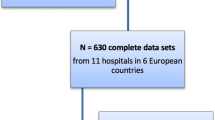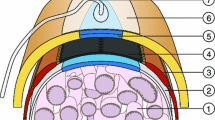Abstract
Purpose
Various techniques for delayed primary fascia closure have been published in patients treated with open abdomen (OA) and application of negative pressure, but to date, no data are available on incisional hernia (IH) rate. The aim of this retrospective analysis was to investigate the long-term outcome of this patient population with special interest in IH development.
Methods
Two hundred and nine consecutive patients, 90(43 %) female, were treated at our institution for various abdominal emergencies involving OA from June 2006 to June 2011. Mean age was 63(16–92) years. The indication was abdominal sepsis in 155(74 %) patients, ischemia in 24(12 %) and other reasons in 30(14 %). Hospital mortality was 21 %(n = 44); and planned ventral hernia was 7 %(n = 15); and mortality until follow-up was 16 %(n = 25), and 9 %(n = 13) patients were lost to follow-up, leaving 112 patients for evaluation of IH development.
Results
The rate of IH for patients with OA and delayed primary fascia closure was overall 35 % at a median (range) follow-up time of 26(12–81) months. Mean time for development of a ventral hernia was 11 months; 21(57 %) patients underwent surgery for symptomatic hernia (2 emergency operations for incarceration). Kaplan–Meier estimate for 5 years gave a 66 % IH rate. BMI, small bowel as source of infection and rapid adsorbable interrupted suture were identified risk factors.
Conclusion
The rate of IH after open abdomen treatment with delayed primary fascia closure is high with a running suture with slow absorbable suture material showing the best results.


Similar content being viewed by others
References
Wild T, Stortecky S, Stremitzer S et al (2006) Abdominal dressing—a new standard in therapy of the open abdomen following secondary peritonitis? Zentralbl Chir 131(Suppl 1):111–114
Regner JL, Kobayashi L, Coimbra R (2012) Surgical strategies for management of the open abdomen. World J Surg 36(3):497–510
Miller PR, Meredith JW, Johnson JC et al (2004) Prospective evaluation of vacuum-assisted fascial closure after open abdomen: planned ventral hernia rate is substantially reduced. Ann Surg 239:608–614
Wondberg D, Larusson HJ, Metzger U, Platz A, Zingg U (2008) Treatment of the open abdomen with the commercially available vacuum-assisted closure system in patients with abdominal sepsis: low primary closure rate. World J Surg 32:2724–2729
Teixeira PG, Salim A, Inaba K et al (2008) A prospective look at the current state of open abdomens. Am Surg 74:891–897
Verdam FJ, Dolmans DE, Loos MJ et al (2011) Delayed primary closure of the septic open abdomen with a dynamic closure system. World J Surg 35:2348–2355
Fieger AJ, Schwatlo F, Mundel DF et al (2011) Abdominal vacuum therapy for the open abdomen—a retrospective analysis of 82 consecutive patients. Zentralbl Chir 136:56–60
Acosta S, Bjarnason T, Petersson U et al (2011) Multicentre prospective study of fascial closure rate after open abdomen with vacuum and mesh-mediated fascial traction. Br J Surg 98:735–743
Justinger C, Slotta JE, Schilling MK (2012) Incisional hernia after abdominal closure with slowly absorbable versus fast absorbable, antibacterial-coated sutures. Surgery 151:398–403
Harlaar JJ, Deerenberg EB, van Ramshorst GH et al (2011) A multicenter randomized controlled trial evaluating the effect of small stitches on the incidence of incisional hernia in midline incisions. BMC Surg 11:20
Jargon D, Friebe V, Hopt UT et al (2008) Risk factors and prevention of incisional hernia–what is evidence-based? Zentralbl Chir 133:453–457
El-Khadrawy OH, Moussa G, Mansour O, Hashish MS (2009) Prophylactic prosthetic reinforcement of midline abdominal incisions in high-risk patients. Hernia 13:267–274
Hollinsky C, Sandberg S, Kocijan R (2007) Preliminary results with the reinforced tension line: a new technique for patients with ventral abdominal wall hernias. Am J Surg 194:234–239
Marwah S, Marwah N, Singh M et al (2005) Addition of rectus sheath relaxation incisions to emergency midline laparotomy for peritonitis to prevent fascial dehiscence. World J Surg 29:235–239
Moussavian MR, Schuld J, Dauer D et al (2010) Long term follow up for incisional hernia after severe secondary peritonitis-incidence and risk factors. Am J Surg 200:229–23416
Mingoli A, Puggioni A, Sgarzini G et al (1999) Incidence of incisional hernia following emergency abdominal surgery. Italian J Gastroenterol Hepatol 31:449–45317
Scholtes M, Kurmann A, Seiler CA et al (2012) Intraperitoneal mesh implantation for fascial dehiscence and open abdomen. World J Surg 36(1557–1561):18
Perathoner A, Klaus A, Mühlmann G, Oberwalder M, Margreiter R, Kafka-Ritsch R (2010) Damage control with abdominal vacuum therapy (VAC) to manage perforated diverticulitis with advanced generalized peritonitis–a proof of concept. Int J Colorectal Dis 25(6):767–774
Kafka-Ritsch R, Zitt M, Schorn N et al (2012) Open abdomen treatment with dynamic sutures and topical negative pressure resulting in a high primary fascia closure rate. World J Surg 36(8):1765–1771
Korenkov M, Paul A, Sauerland S et al (2001) Classification and surgical treatment of incisional hernia. Results of an experts’ meeting. Langenbecks Arch Surg 386:65–73
Mysoms FE, Miwerez M, Berrevoet F et al (2009) Classification of primary and incisional wall hernias. Hernia 13:407–414
Björck M, Bruhin A, Cheatham M et al (2009) Classification: important step to improve management of patients with an open abdomen. World J Surg 33:1154–1157
Linder MM, Wacha H, Feldmann U et al (1987) The Mannheim peritonitis index. An instrument for the intraoperative prognosis of peritonitis. Chirurg 58:84–92
Leppaniemi A, Tukiainen E (2012) Planned hernia repair and late abdominal wall reconstruction. World J Surg 36:511–515
Diener MK, Voss S, Jensen K et al (2010) Elective midline laparotomy closure: the INLINE systematic review and meta-analysis. Ann Surg 251(5):843–856
Kafka R, Laimer E, Perathoner A (2012) Damage control surgery with abdominal vacuum and delayed bowel reconstruction in patients with perforated diverticulitis Hinchey III/IV. J Gastrointest Surg 16(10):1915–1922
Cobb WS, Carbonell AM, Kalbaugh CL, Jones Y, Lokey JS (2009) Infection risk of open placement of intraperitoneal composite mesh. Am Surg 75:762–767
Jezupors A, Mihelsons M (2006) The analysis of infection after polypropylene mesh repair of abdominal wall hernias. World J Surg 30:2270–2278
Dietz U, Wichelmann C, Wunder C et al (2012) Early repair of open abdomen with a tailored two-component mesh and conditioning vacuum packing: a safe alternative to the planned giant ventral hernia. Hernia 16:451–460
Conflict of interest
All authors declare no conflict of interest.
Author information
Authors and Affiliations
Corresponding author
Rights and permissions
About this article
Cite this article
Brandl, A., Laimer, E., Perathoner, A. et al. Incisional hernia rate after open abdomen treatment with negative pressure and delayed primary fascia closure. Hernia 18, 105–111 (2014). https://doi.org/10.1007/s10029-013-1064-0
Received:
Accepted:
Published:
Issue Date:
DOI: https://doi.org/10.1007/s10029-013-1064-0




